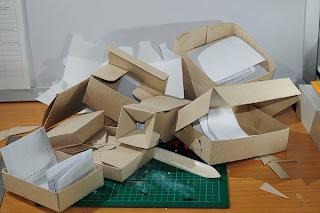Saturday, July 31, 2010
Thursday, July 29, 2010
Packaging Mania
this one was the only that had required glue, i really liked this net because i feel it was the most challenging, the top of the box pulls in and out, when pushed down, it closes it self.
Start of the growing experiment
So it has been a week into the growing experiment, there isnt much happening, im not sure if the seeds are dying or not, i might give it another week or so. But yeah before this experiment, i was still exploring different packages and certain folds how they held the tension of itself etc. ireally like the muji speaker flaps, which inserted itself into each other which created a strong hold, so i used this as inspiration for the bottom of the box and how it was to hold down the sides, the overall shape was like ... a noodle canteen box (not sure what the technical term was) but it resembled how existing pots are i think.
Thursday, July 22, 2010
Timelapse
So after the group meet up, not really clearly as to where I'm heading towards, but something that kept popping up was like who is using this, in what context, basically i read it as some kind of point of difference to other real innovative products out there already in my precedents. like where was their starting point to get to their final.
So Mark asked if i was growing myself, the answer was that i wasn't, afterwards i was thinking why wasn't i, if this was what i was trying to promote. so i think it might be little late to start, but i am going to start to try grow small punnets of herbs in realistic conditions to wellington, on a cold window still. kind of a small experiment, small variables i think such as arrogation at the bottom, nutrients drops, also this way, i can sort of test how the cardboard reacts to the moisture etc of the plant. in the end, i hope to have more of a understanding of what's best for the package etc.
so it would be awesome to document this process of course, so i've just made up a small time-lapse video of a folding experiment, first time ever, so simple to create as well which is good.
Sunday, July 18, 2010
Boxal

Pretty cool product and idea i stumbled on, has some very relevant elements of what my project is about, food and packaging. the fact its made of cardboard, so i assume it is pretty sustainable in the way it is made and disposed of, $35 bit steep for is essentially a cardboard box, but apparently according to the website, the boxes are beefy enough for multiple uses. Different aesthetics for different to suit different scenarios could be something i could look into.
"Boxal might be just the thing you need this summer. It's an eco-friendly cardboard picnic box that makes picnicking cool again. Each Boxal comes equipped with an Eatin' Tool set that includes: 4 Compostable trays, 4 Compostable large bowls, 4 Compostable small bowls, 4 Compostable utensil sets, 4 Compostable cold cups, 8 Recycled napkins and 1 Compostable trash bag"
Wednesday, July 7, 2010
Life Box



Fungi expert Paul Stamets' Life Box infuses cardboard with seeds for a plantable shipping container. Simply tear up the box, bury it in the ground and water the area to get various forms of vegetation to sprout. Made from recycled paper and printed with soy-based inks, the box contains about 100 tree seeds that have mycorrhizal fungal spores. Trees and fungi live in a symbiotic relation, and as the trees begin to grow, the fungi can help nurture and protect the tree against drought and famine.
If one tree out of the hundreds of seeds grows for 30 years, it will offset approximately one ton of carbon. Highlighted on Good, contributor Andrew Price says of the boxes that start at $33 for a set of 10, "If you run a company that could use these instead of normal cardboard, I will happily trade a public endorsement of your product in the Good blog for a pledge to switch to these things."
Monday, June 14, 2010
Subscribe to:
Posts (Atom)




























